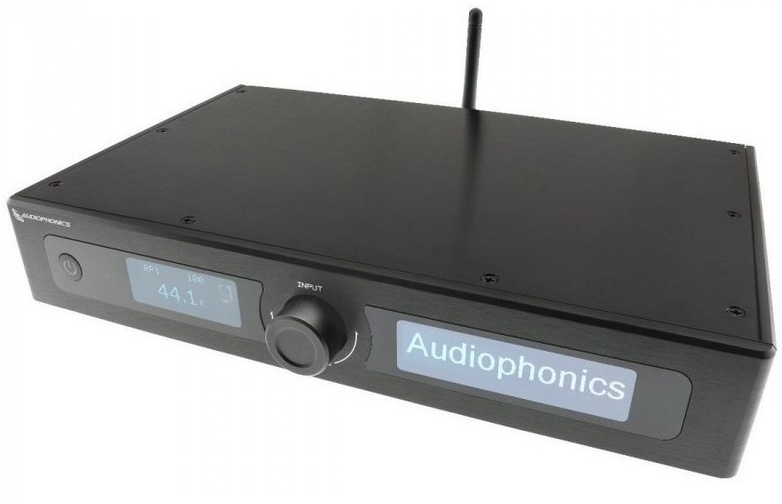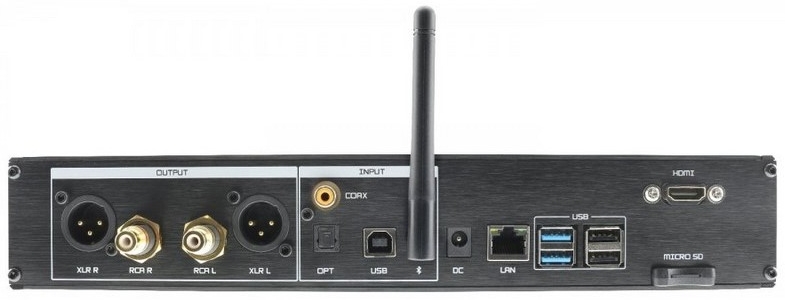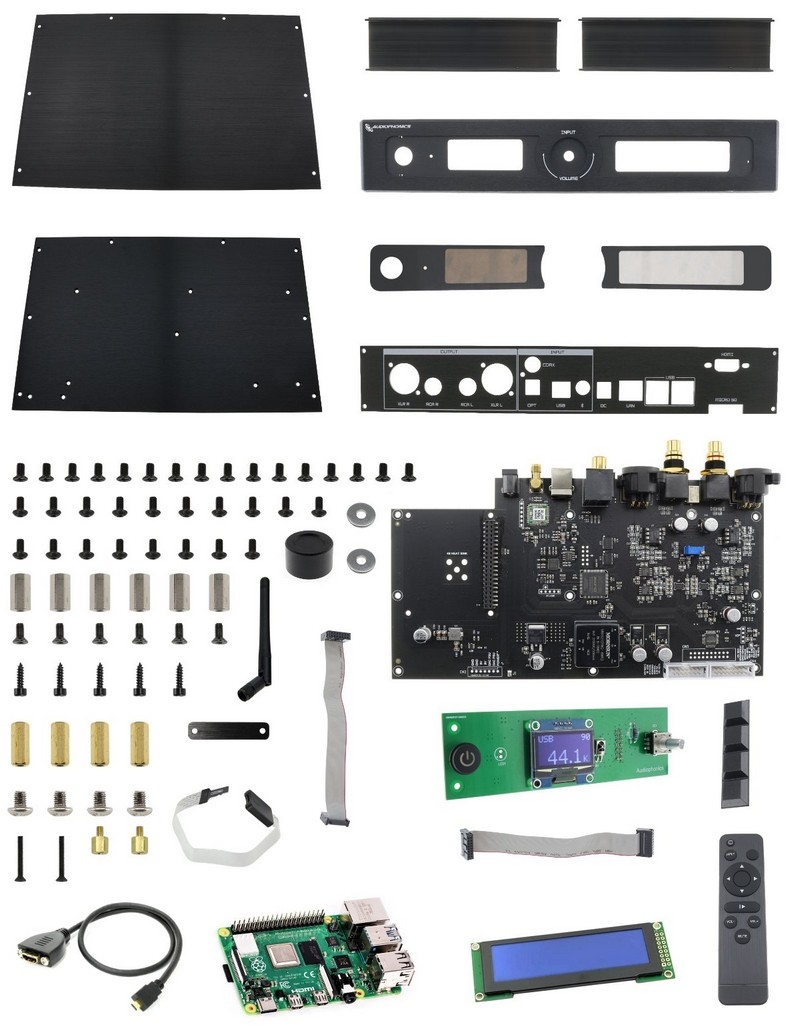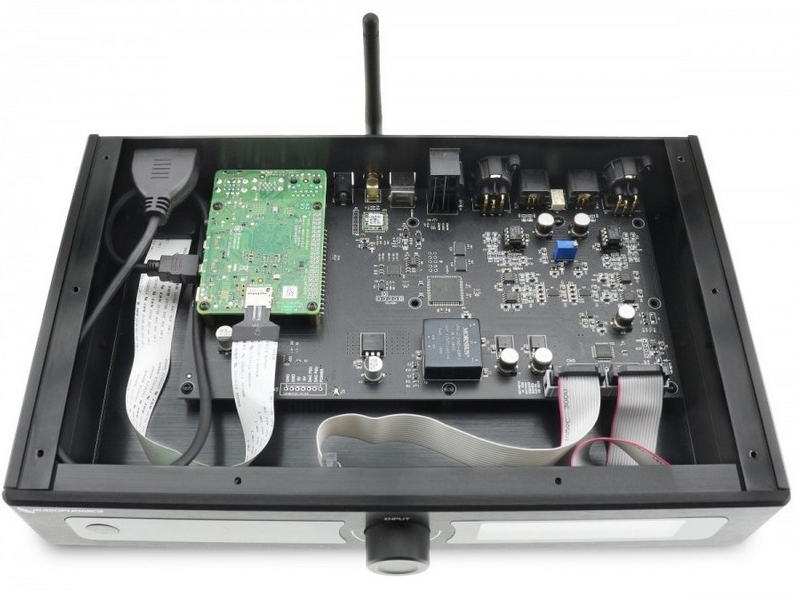Audiophonics EVO DAC

[ Home TNT-Audio | Staff & Contacts | HiFi Playground | Listening tests | DIY & Tweakings | Music & Books ]
Product name: Audiophonics EVO Sabre DAC
Manufacturer: Audiophonics - France
Cost: 459€ (Currency conversion) - (YMMV)
Reviewer: Graeme Budd - TNT-Audio France
Reviewed: December, 2023
This review represents something entirely new to me. I've done a DAC
before, I've done a streamer before but in both cases they came fully
assembled. Today I'm going to talk about a DAC/Streamer you have to build
yourself. Now I hope half of you haven't abandoned yet with the thought of
DIY as in reality it's really easy, there's no soldering and I can vouch
that no children or small animals were hurt during the build.
So with that disclaimer out of the way we can start on the Audiophonics
EVO Sabre DAC. I can claim no credit for finding this product as it was
Lucio who suggested it, but as they're based in France I got the
opportunity to try it and I'm glad I did. The component is a combined
ES9038Q2M SABRE 32-bit equipped DAC with Coax, Optical, Bluetooth, and USB
inputs combined with a Raspberry Pi Single board computer to turn it into
a streaming solution.

It comes as a kit of parts and takes about an hour to build and then a further hour to get the Raspberry Pi up and running with the software of your choice (several options are already pre-defined). I'm going to come clean here and admit it took me longer to get the Raspberry up and running as I downloaded the wrong version of the software (there is a specific version for the EVO) which created quite a bit of frustration but once I'd RTFM it fired up within an hour. But more on that a bit later.
As I mentioned everything is simple and frankly if you can change a plug you should be fine. If you ever did a RC car as a kid then you'll be laughing. It's that simple. The resultant product is more functional than pretty and if I'm being critical you can see down the side of one of the screens if you are closer than a couple of feet away.
Below is a picture of what you have to assemble. As I mentioned above it all goes together in about an hour and can be used as a standalone DAC at this point although you're missing out on the streaming possibilities if you stop now. In my case I connected up the supplied medical grade (although physically noisy) power supply to get the streaming set up.

But before we go any further here's what it looks like with everything installed minus lid. Simple and tidy and with an overall high quality feel. OK there aren't any Black Gate capacitors or WBT Next Gen Connectors or machined heat sinks but I think it's well laid out and well made for the price.

Adding some form of operating system onto the Raspberry Pi opens up a land of opportunity and adventure. As I alluded to above the important bit at this point is that Audiophonics have created a version of Volumio specific to the EVO and if you try and install the standard version things will go wrong. Before starting you'll need a (not supplied) micro SD card to flash the OS onto and ideally an HDMI monitor to monitor progress. If you follow the instructions with the right OS version the EVO turns into a Volumio player as well as a DAC. It creates its own wireless network so you can complete the setup using a smartphone or tablet with the Volumio app or via a PC with the Volumio web interface. Once setup is completed I ran everything via my wired network.
The Volumio interface is pretty intuitive and I was quickly able to sync my music collection on my server and even had internet radio up and running. OK internet radio can be extremely ropey in the sound quality dept but as a tool for discovering new music and a few "haven't heard that for ages" moments it definitely has its place. Volumio can be used as a free OS or there is a reasonably priced yearly plan which allows you to use multiple players for multi room and integration with Spotify and the like. My only criticism is it won't integrate with Deezer but this is Deezer's fault as they continually bury their heads in the sand whenever DLNA/UPnP is mentioned. Which is a shame as they have FLAC streaming, a large catalogue (even if Black Grape's Stupid Stupid Stupid is missing) and a well priced family offer
The EVO is very simple to use and everything is controlled by either the rotary knob on the front or via the remote which appears to be fairy generic but works well so long as you don't lose it down the back of the sofa as it's quite small.
The rotary allows input switching, volume control and you can even switch between a variety of digital filter options if that takes your fancy. I think most people will find the one they like best and leave it as is especially as the differences are subtle. I found the apodizing fast to my liking and did the vast majority of my listening in this configuration.
As the photo above shows the EVO has a large amount of connections so I tried a variety of sources to see what it could do. These were in no particular order:
To cut a long story short performance is rather good on all inputs. They're nowhere that the EVO lets the side down. It is cable sensitive on coax and one of my old coax cables sometimes wouldn't lock the data stream. A change to a more recent and better cable sorted this out. Everything else locked in immediately be the stream at 44.1, 48 or 96kHz.
With the Volumio player it managed to get the best out of internet radio and with a set of Argon Audio active speakers (around 599€) provided a rather satisfying all in one solution for just over 1000€ that kept me company while the main system was in rebuild mode. Yes, internet radio is a bit(!) shoddy - something inherent in the format - but the EVO manages to get the best out it and with FLAC radios such as those from Naim Audio it didn't ever leave me wanting when it was put back in the main system
To be honest the same is true over all the inputs but as this is the sound part I guess we should compare it with something else.
I put it up against the onboard DAC in the Audio Note CD2.1X II using this rather fine (and rather pricey at around 5000€) CD player as a transport for both its internal DAC and the EVO. So assuming the DAC in the CD2.1X II counts for half the component's value the EVO was up against something five times its price.
I'm going to ruin the suspense here as NO, it isn't as good as the CD2.1X II but it'll take a few tracks to really see just where the EVO lacks. And even then the “faults” are more of a detail nature rather than actual omissions.
The EVO puts in a more than creditable performance. On the London
Grammar track “If you wait” the piano is clearly set in space in front of
you behind the voice. The top notes in what is quite a challenging vocal
part don't shriek or head into harshness. Play the opening track "Hey Now"
off the same album and the bass is precise and well pitched. And if you
never tried anything better you'd likely be more than happy with what
you're hearing.
But... play the tracks again using the player's internal DAC and the
chinks in the EVOs armour appear. The piano in If you wait suddenly
becomes a human playing piano with life and flow leaving the EVO sounding
slightly mechanical as if the piano itself is of lower quality. Hey now
will have the guitar better placed in space and the bass sound more
organic and again more like the synth in question no doubt sounded like in
the studio
Some of you may think I'm being harsh here but let's put things into context. The CD2.1X II is one of the best CD players I've ever had in my system and brings a wonderful musical flow to proceedings due I'm sure in some part to its filter less DAC which is hard to find elsewhere.
The EVO is under 500€ whereas the CD2.1X II retails for the best part of 5000€ as a one box player and will only play CDs!
In reality its performance is highly credible. Run it with an NAS drive or laptop (which you probably already have) and you'll be hard pushed to call a winner with a 1000€ CD player. It certainly keeps up with my Naim CD5i (which retailed at 1400€ 20 years ago) and some of you would probably even prefer it depending where your priorities lie. Any flaws are of detail and are only shown up by vastly more expensive machines.
I've enjoyed using the Audiophonics EVO Sabre a lot. It was fun to
build, easy to configure (do read the manual though otherwise it can be
frustrating as you'll get it wrong like I did).
Performance wise it was never less that enjoyable and has allowed me to
rediscover a lot of old music from streaming platforms that otherwise
would have remained on cassettes at my parents' house for the next few
years.
For beginners it represents a serious entry into the world of hifi when
paired with a set of active 2 way monitors where it will delight it's
owners. The best bit is that the EVO will then still hold its own when we
go up the range to something a bit more revealing...
It has certainly opened my eyes to the DIY assembly route and I will definitely be keeping
my eyes on the Audiophonics website for future projects.
DISCLAIMER. TNT-Audio is a 100% independent magazine that neither accepts advertising from companies nor requires readers to register or pay for subscriptions. If you wish, you can support our independent reviews via a PayPal donation. After publication of reviews, the authors do not retain samples other than on long-term loan for further evaluation or comparison with later-received gear. Hence, all contents are written free of any “editorial” or “advertising” influence, and all reviews in this publication, positive or negative, reflect the independent opinions of their respective authors. TNT-Audio will publish all manufacturer responses, subject to the reviewer's right to reply in turn.
© Copyright 2023 Graeme Budd - graeme@tnt-audio.com - www.tnt-audio.com
[ Home TNT-Audio | Staff & Contacts | HiFi Playground | Listening tests | DIY & Tweakings | Music & Books ]